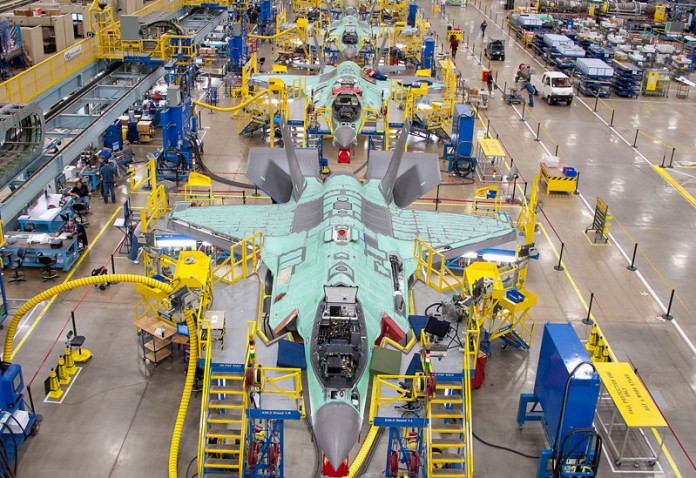The US Department of Defense (DoD) has released today details on major defense acquisition program cost, schedule, and performance changes since the December 2013 reporting period. In aggregate, the current SAR reflects a cost decrease of more than $9 billion (-0.6 percent) for the 79 Selected Acquisition Reports (SARs) totaling $1.6 trillion, submitted to the Congress for the December 2014 reporting period.
The biggest saving reported in 2014 was in the F-35 Joint Strike Fighter (JSF) and F-135 engine program, that decreased $7.4 billion in the cost of Research, Development, Test & Evaluation (RDT&E), procurement and infrastructure spending over the 32 production years (from $398.5 bn to $391.1 bn). According to Lockheed Martin, the actual contract negotiated cost of aircraft and engine with fee (LRIP 8) continues to come down, and remains well below the SAR lot yearly URF estimates. The current average F-35A price is $108 million (with engine) and is $4 million lower than lot 7 prices.
The cost of Operations and Sustainment (O&S) for the 65 year lifetime of the F-35 program is expected to be three times the procurement cost, and is estimated by the Director, Cost Assessment and Program Evaluation at $1016.5 bn. CAPE, which also authors the SAR, does not update program O&S cost numbers until a major program milestone is reached. However, the F-35 Joint Program Office (JPO) estimates the revised overall O&S cost at $859 bn.
A $9.1 billion saving was achieved by revising accounting estimates, incorporating the latest labor rates for all variants of the F-35, as agreed with prime contractor Lockheed Martin and its subcontractors, along with revised escalation indices. Further savings were achieved in the cost of initial spares requirements, due to maturation of the technical baseline and definition of customer requirements and bed down/fielding plans. These decreases were partially offset by increases for revised airframe estimates based on actual costs from early low rate initial production lots (+$4.6 billion).
[nonmember]Subscribe to read more highlights on the SAR report[/nonmember][ismember]Among the Air Force programs, additional procurement of 21,509 Joint Direct Attack Munition (JDAM) weapon tailkits has increased the program cost by +13.0%. The Evolved Expendable Launch Vehicle (EELV) Program costs decreased $2.8 bn. due primarily to revised estimating assumptions for FY 2021 to FY 2030. Ballistic Missile Defense System (BMDS) Program costs have increased 5.9%, due primarily to additional funding for Ground-Based Midcourse Defense reliability improvements.
Among the most significant savings in Army programs, decreases were reported in the Joint Tactical Radio System Handheld, Manpack, and Small Form Fit Radios (JTRS HMS) (-$1.7 bn (reflecting 13.9% drop to $10.5 bn program cost currently estimated). The Patriot Advanced Capability-3 Missile Segment Enhancement (PAC-3 MSE)– Program costs has also decreased $2.6 bn (-28.2%) and is currently estimated to cost $6.82 billion. The cost saving has been achieved due to 33 percent reduction of acquisition quantities (the Army reduced PAC-3 MSE buy by 435 missiles) and reduce support requirements. The Army also saved $1.85 bn in the Warfighter Information Network-Tactical Increment 3 (WIN-T Inc 3) – Program, due to the elimination of further procurement of 699 nodes, shifting the funding to buy more of early generation WIN-T Inc 2 terminals).
Among Navy programs, procurement of additional vessels in the DDG 51 Arleigh Burke Class Guided Missile Destroyer Program, reflect costs increased $4,303.3 million (+4.6%). The Amphibious Transport Dock LPD 17 San Antonio Class Program costs has also increased by $1.6 bn with the planned increase from 11 to 12 vessels of this class. The SSN 774 Virginia Class Submarine Program costs have also increased by $6.76 bn (+7.3%), with the planned production of two additional submarines. The cost of the EA-18G Growler Aircraft Program has also increased +11.9% ($1.56 bn) reflecting an additional procurement of 15 aircraft and associated support. Additional fund was added to support the Complex Emitter, Tactical Targeting Network Technology, and Distributed Targeting Processor-Networked efforts also included under the EA-18G. program.
The Navy plans to save over 0.6 billion in the MQ-4C Triton Unmanned Aircraft System support, by decreasing initial spares resulting from a change from contractor logistics support to organic maintenance support. Another Navy UAS program – the MQ-8 Fire Scout, is also expected to save $0.6 billion over its lifetime due to the reduction in the number of aircraft to be operated, from 119 to 61.[/ismember]
SARs summarize the latest estimates of cost, schedule, and performance status. The recent release include 79 program SARs. The total program cost estimates provided in the SARs include research and development, procurement, military construction, and acquisition-related operations and maintenance. Total program costs reflect actual costs to date as well as future anticipated costs. All estimates are shown in fully inflated then-year dollars.




















